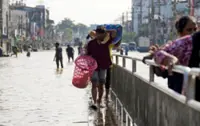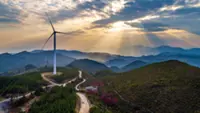The sunrise appears between the branches of a dragon’s blood tree. — Photos: ANNIKA HAMMERSCHLAG
On a windswept plateau high above the Arabian Sea, Sena Keybani cradles a sapling that barely reaches her ankle.
The young plant, protected by a makeshift fence of wood and wire, is a kind of dragon’s blood tree – a species found only on the Yemeni island of Socotra that is now struggling to survive intensifying threats from climate change.





